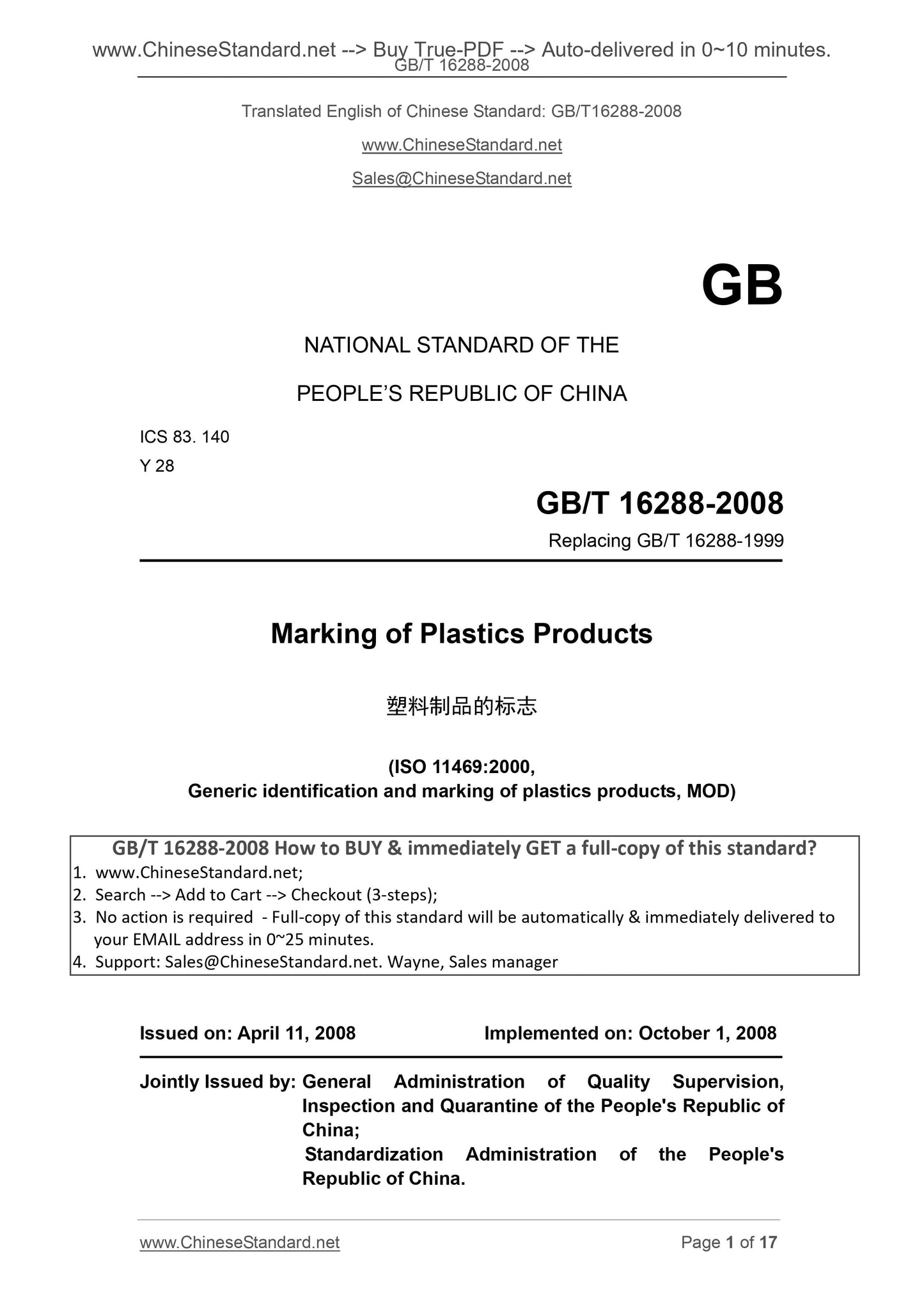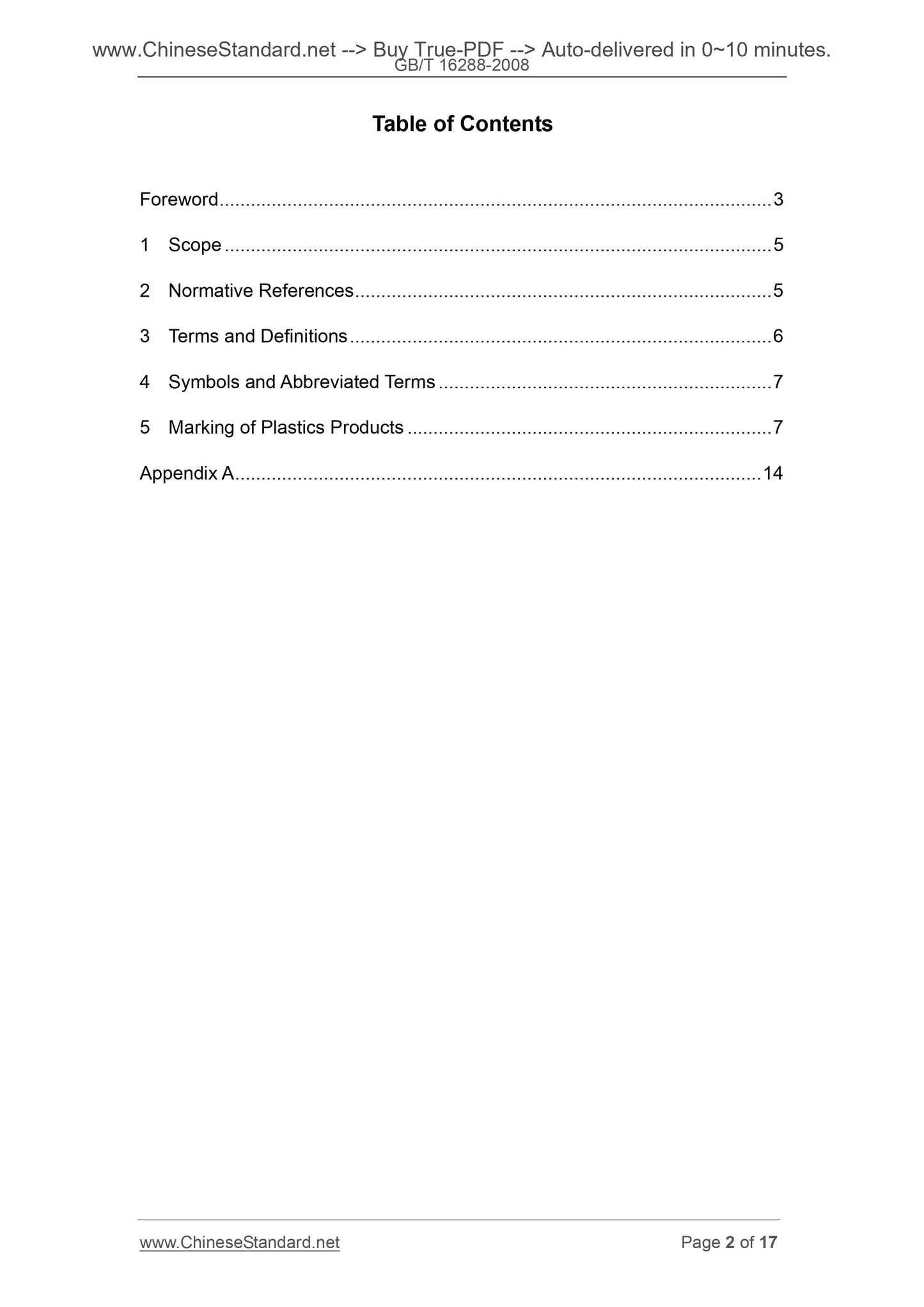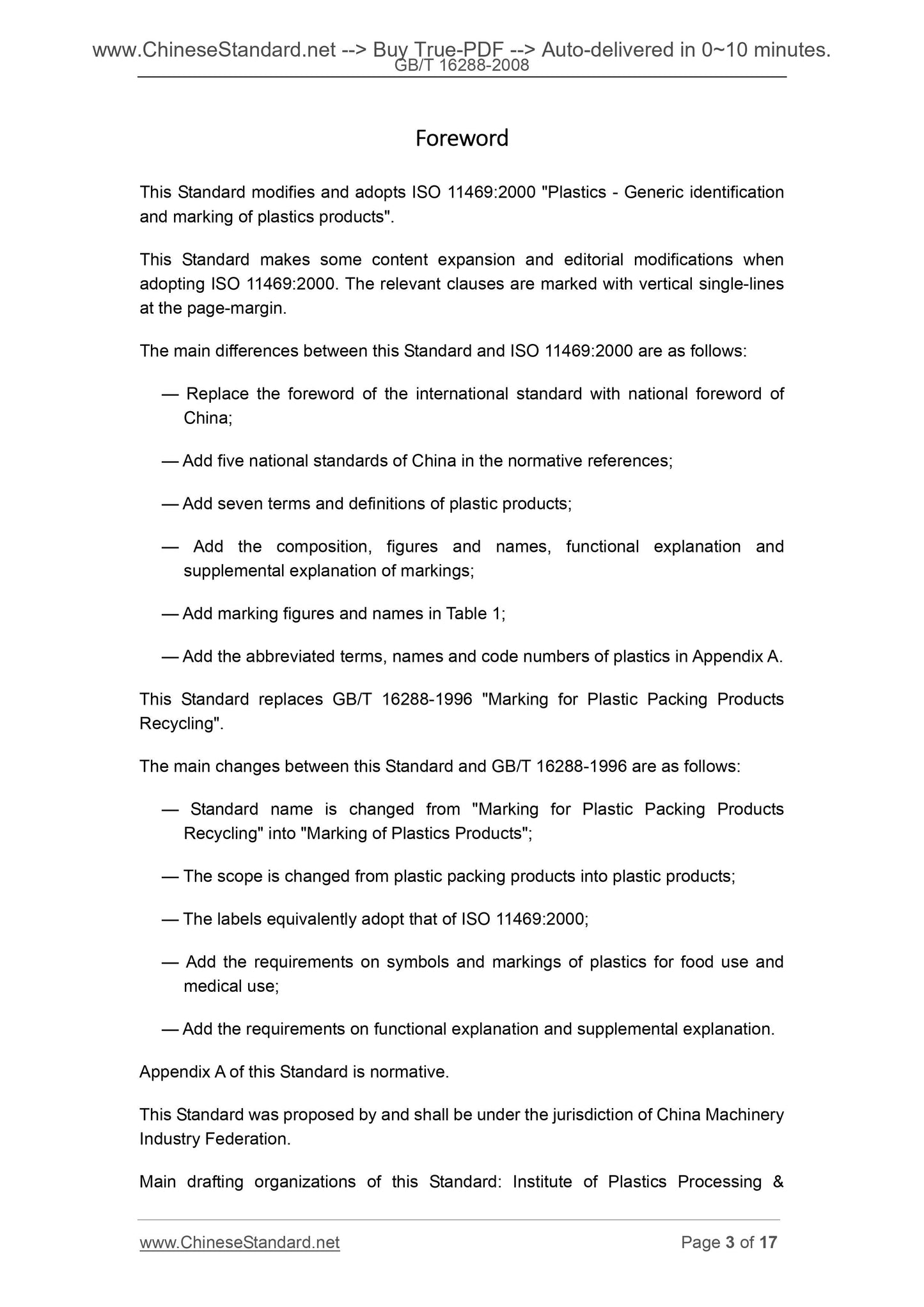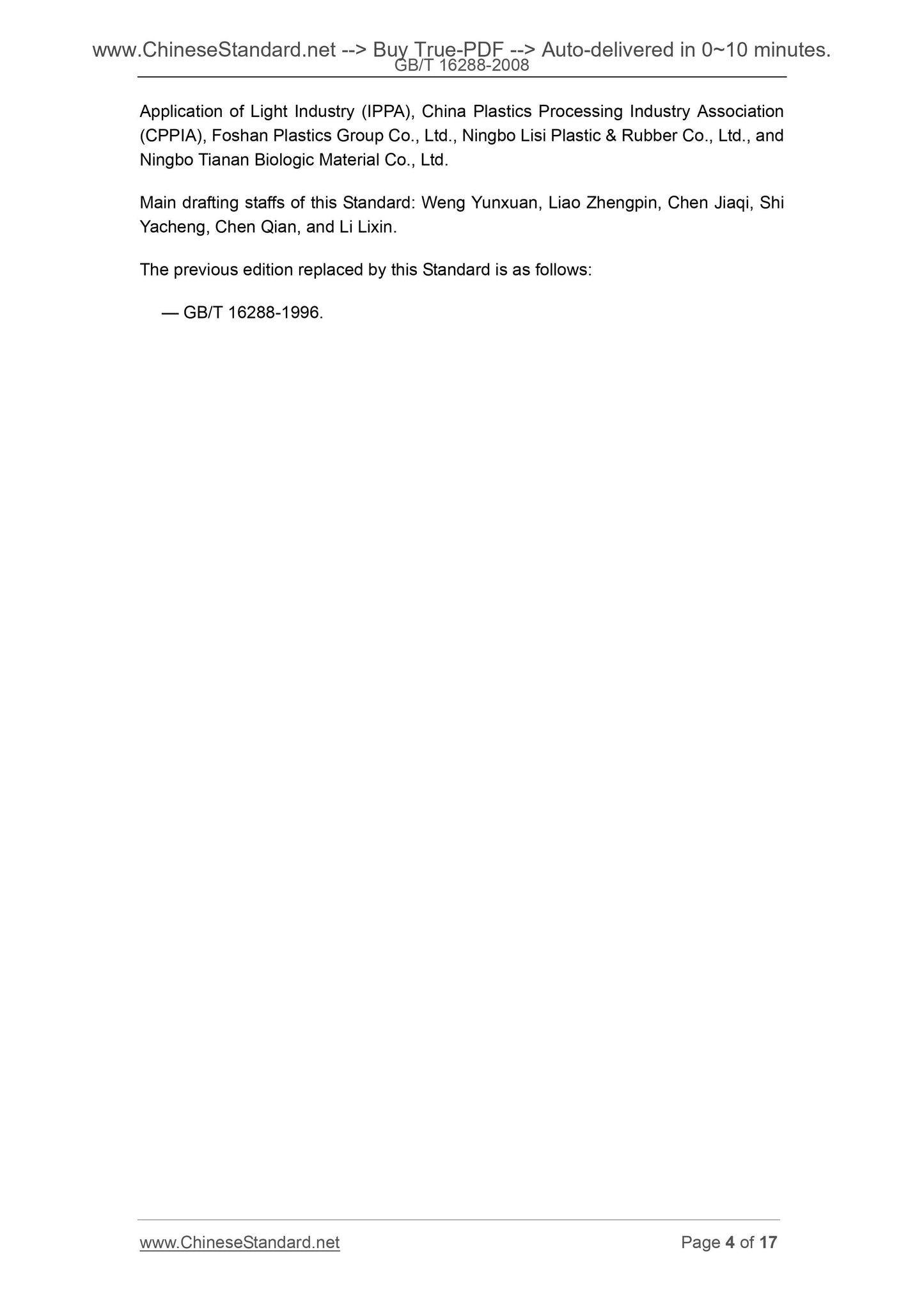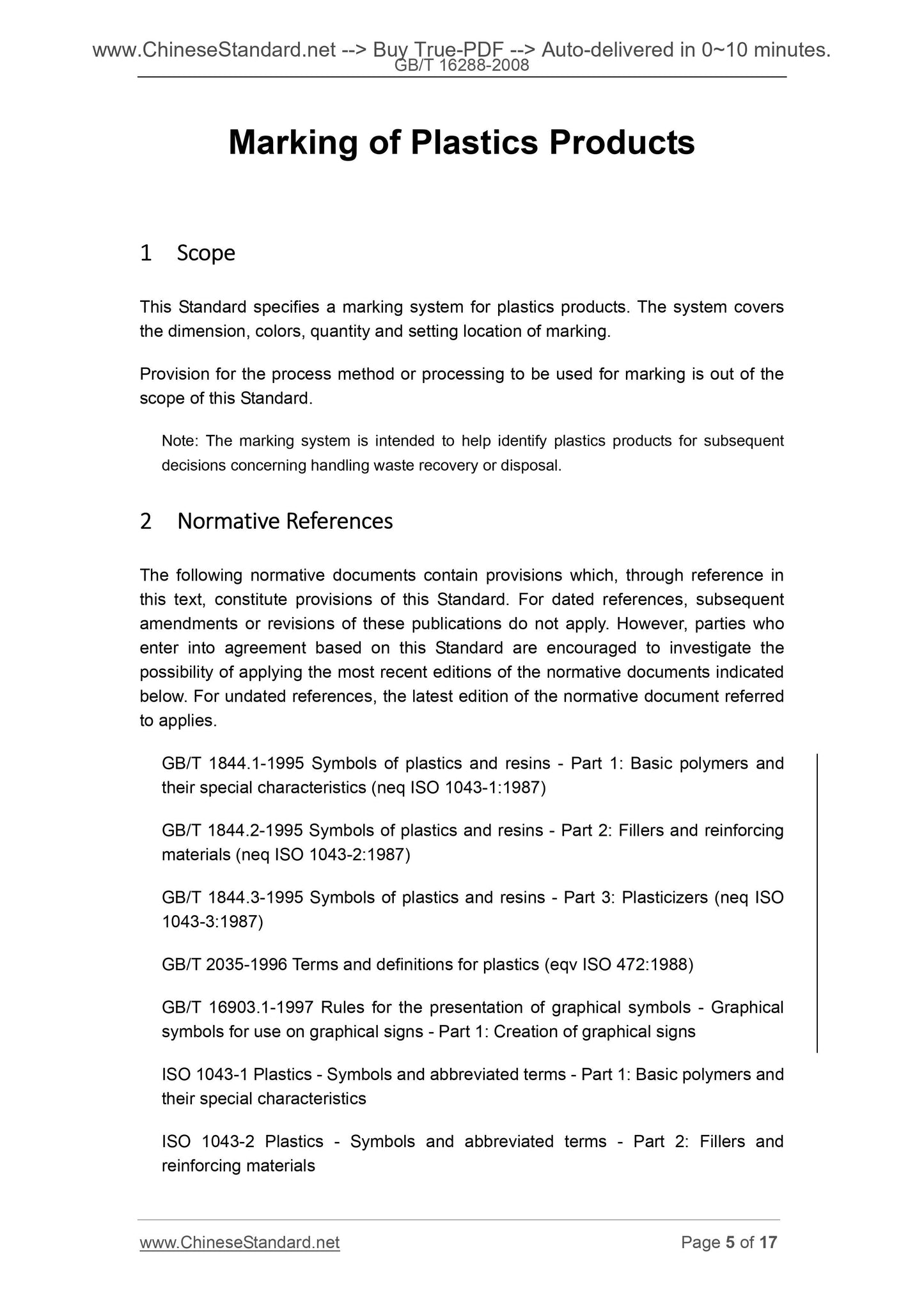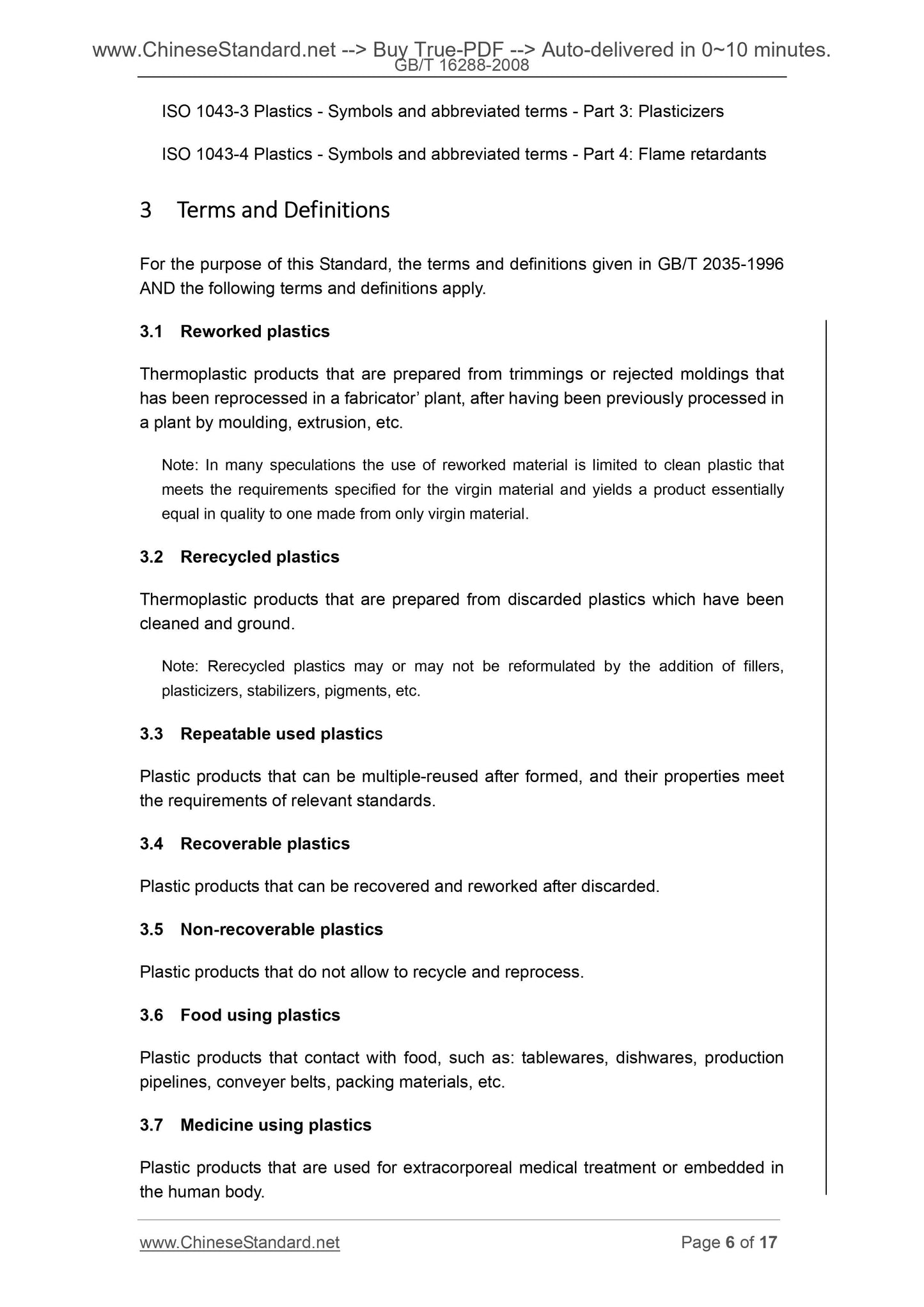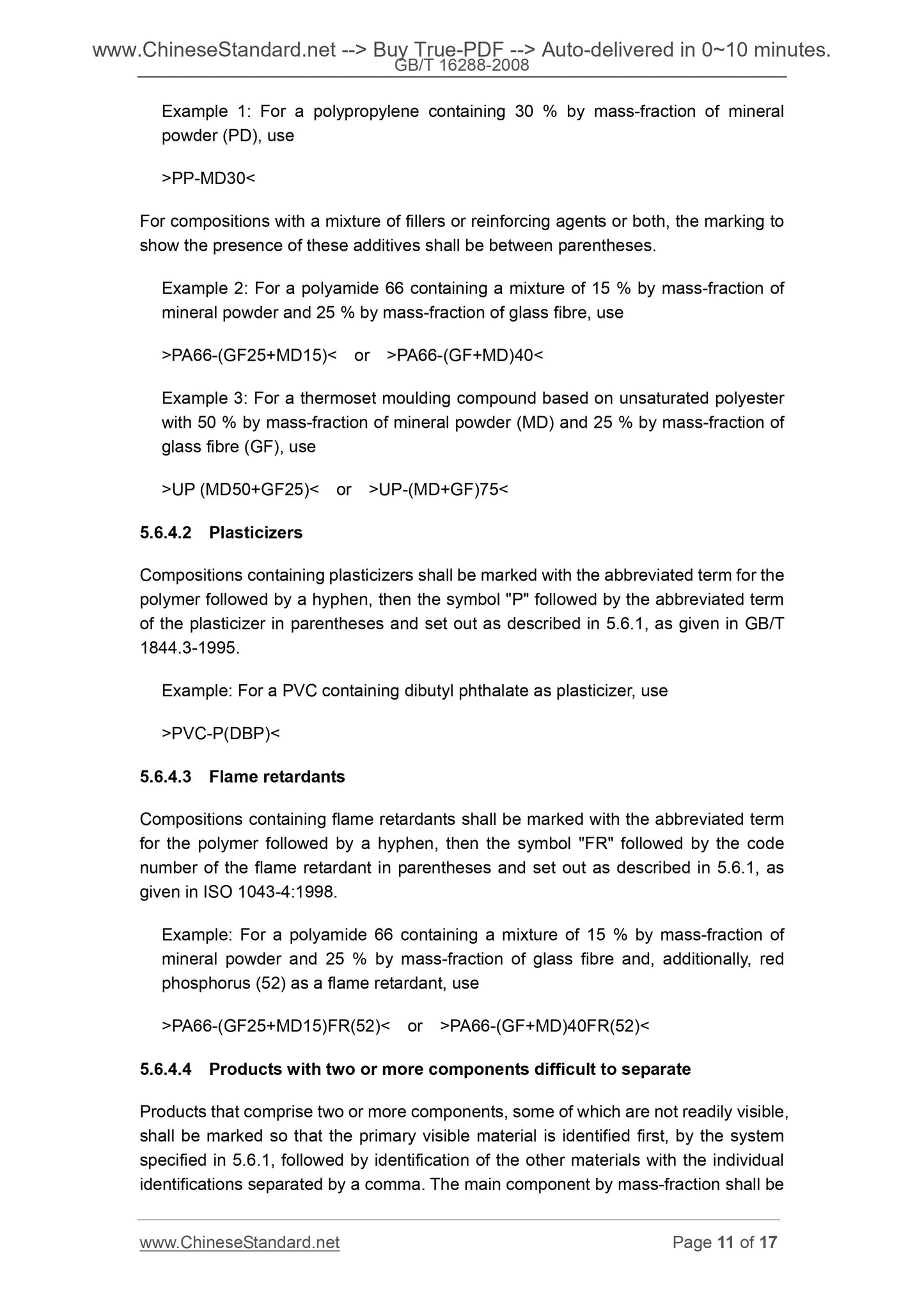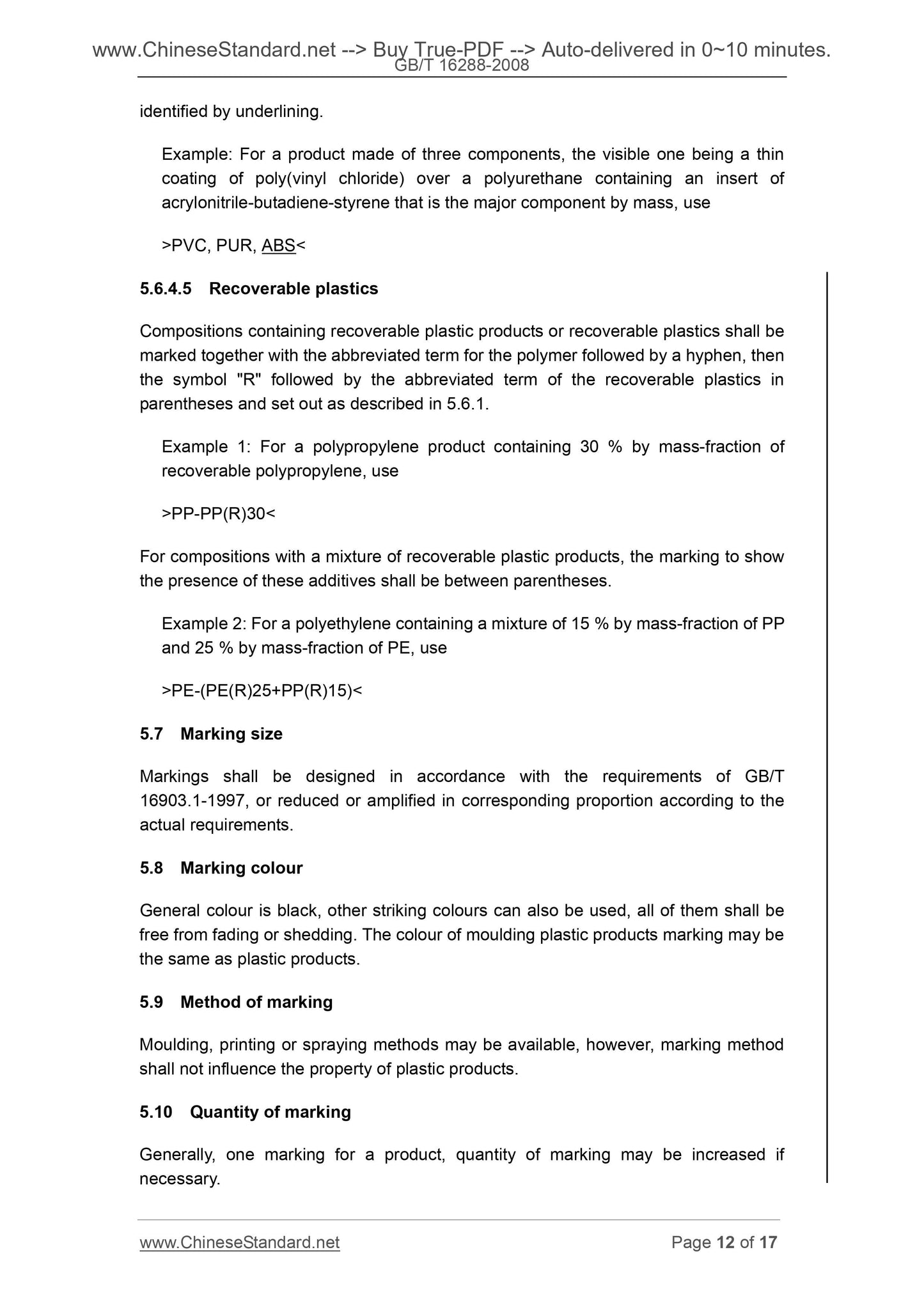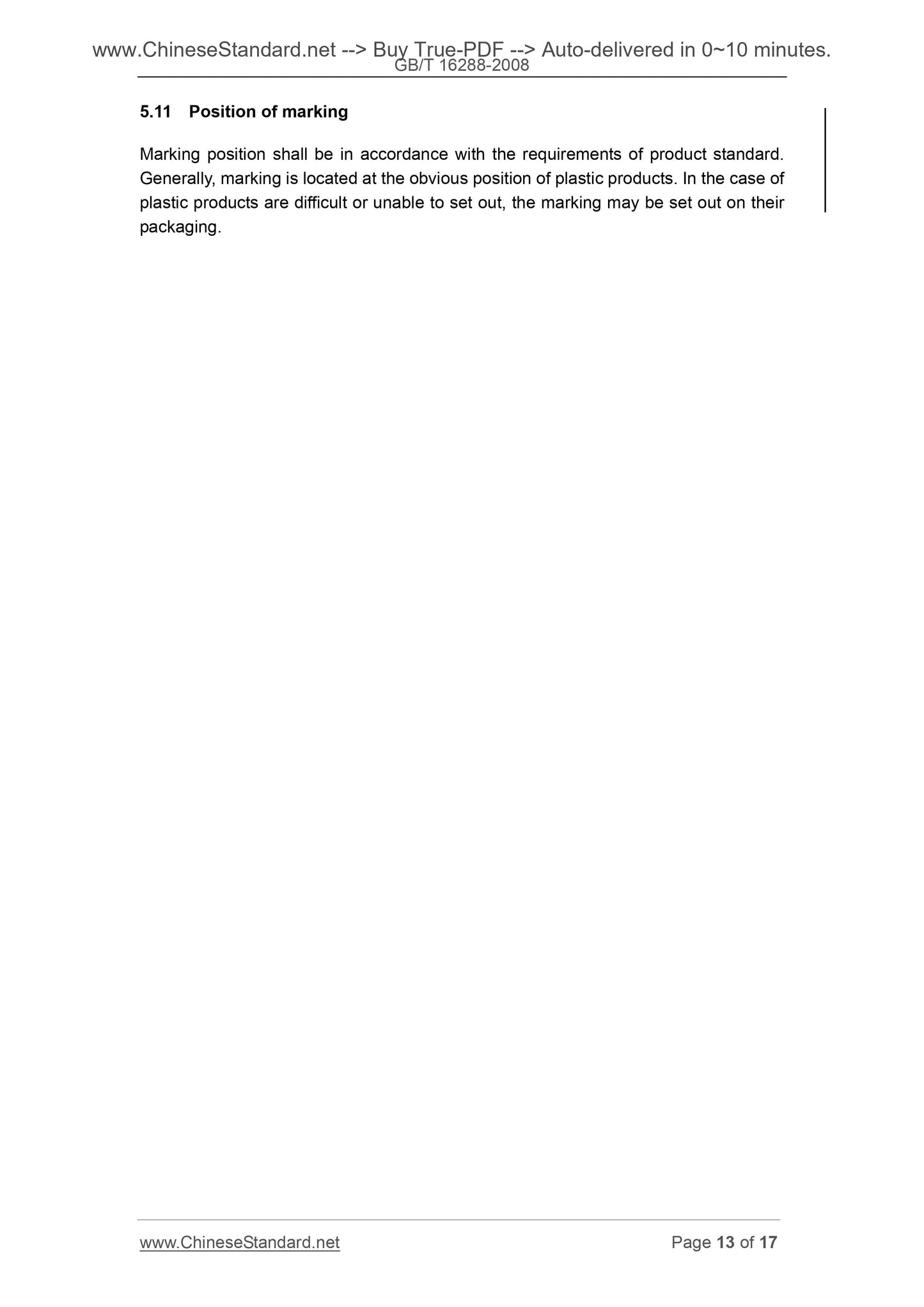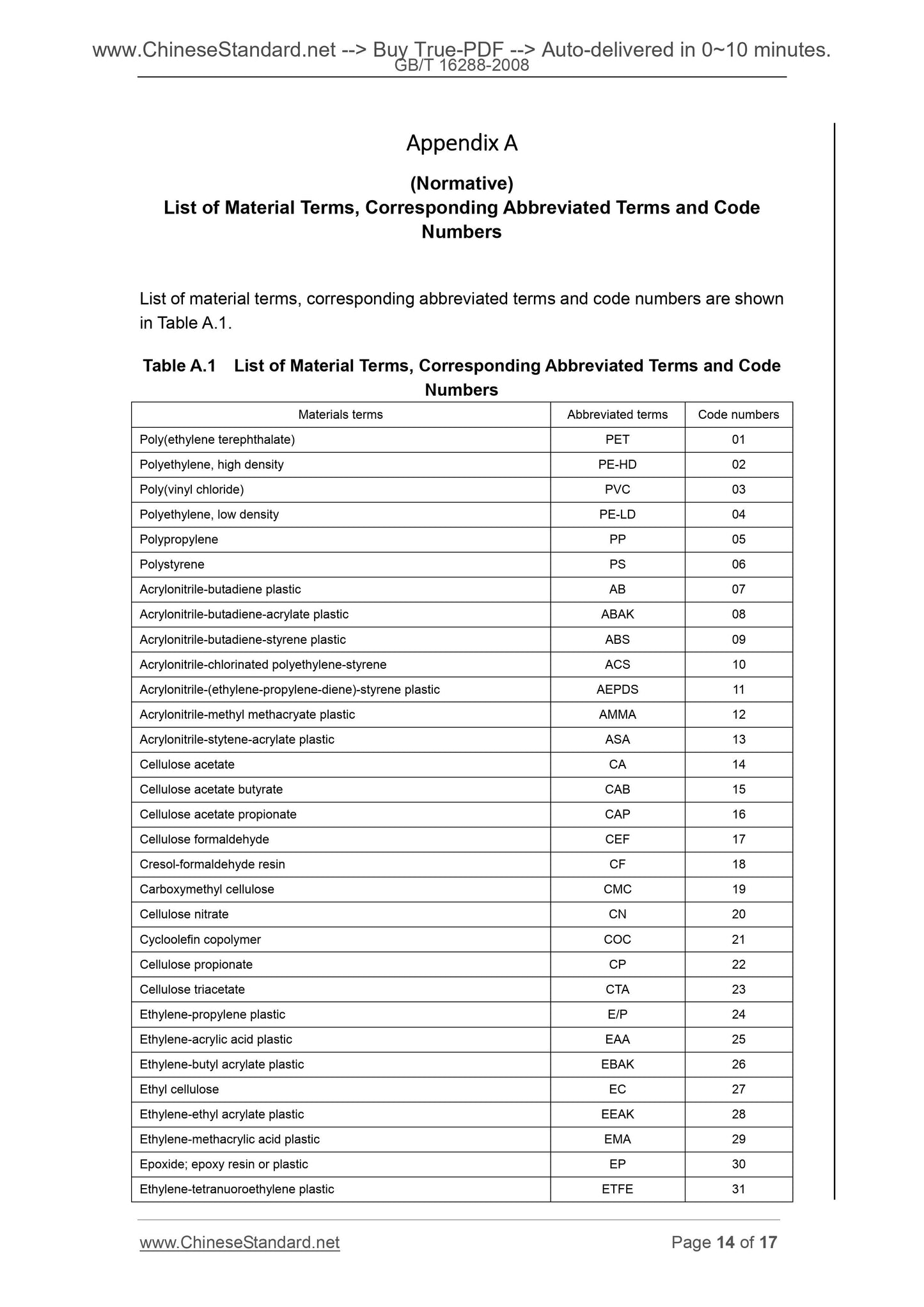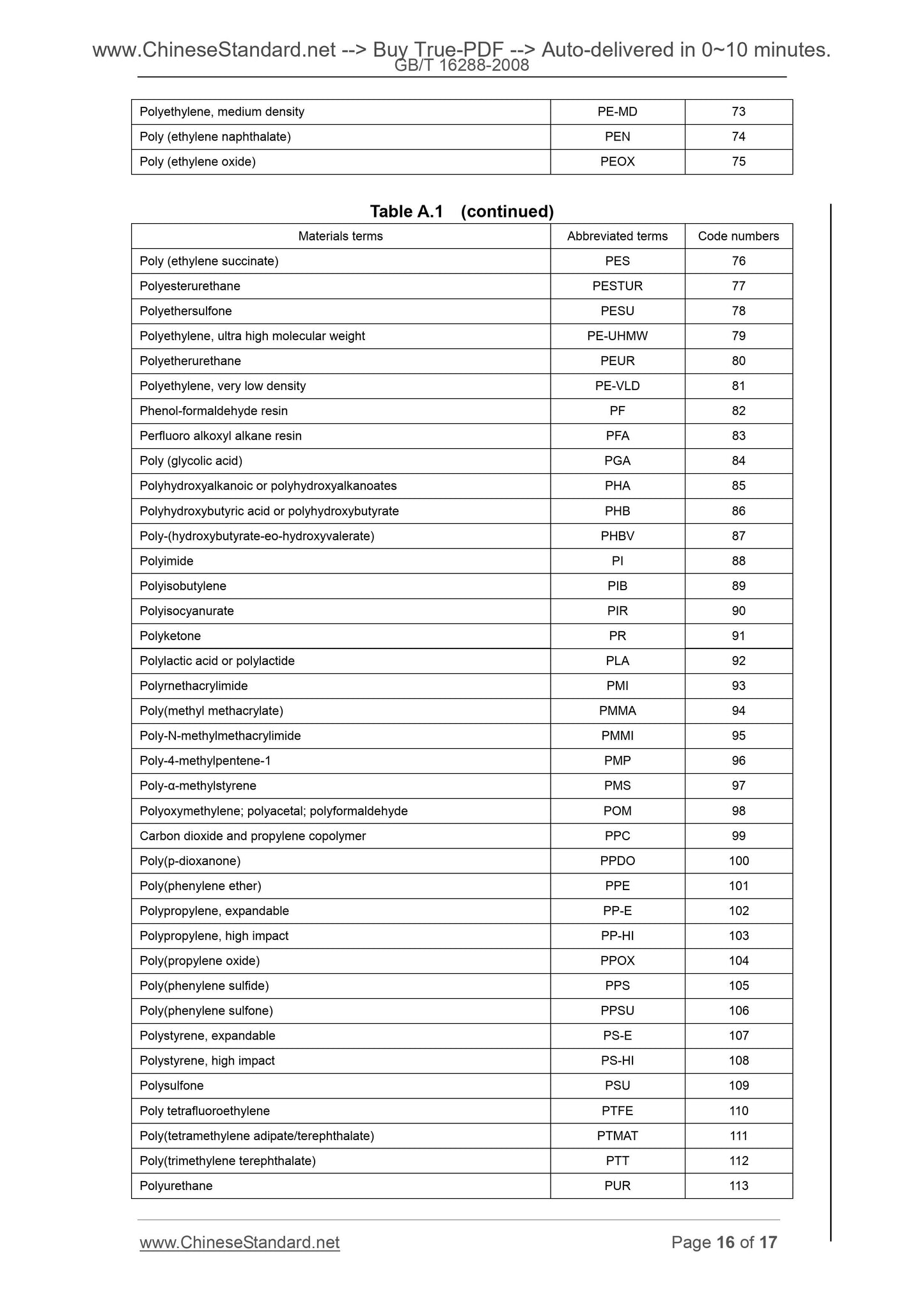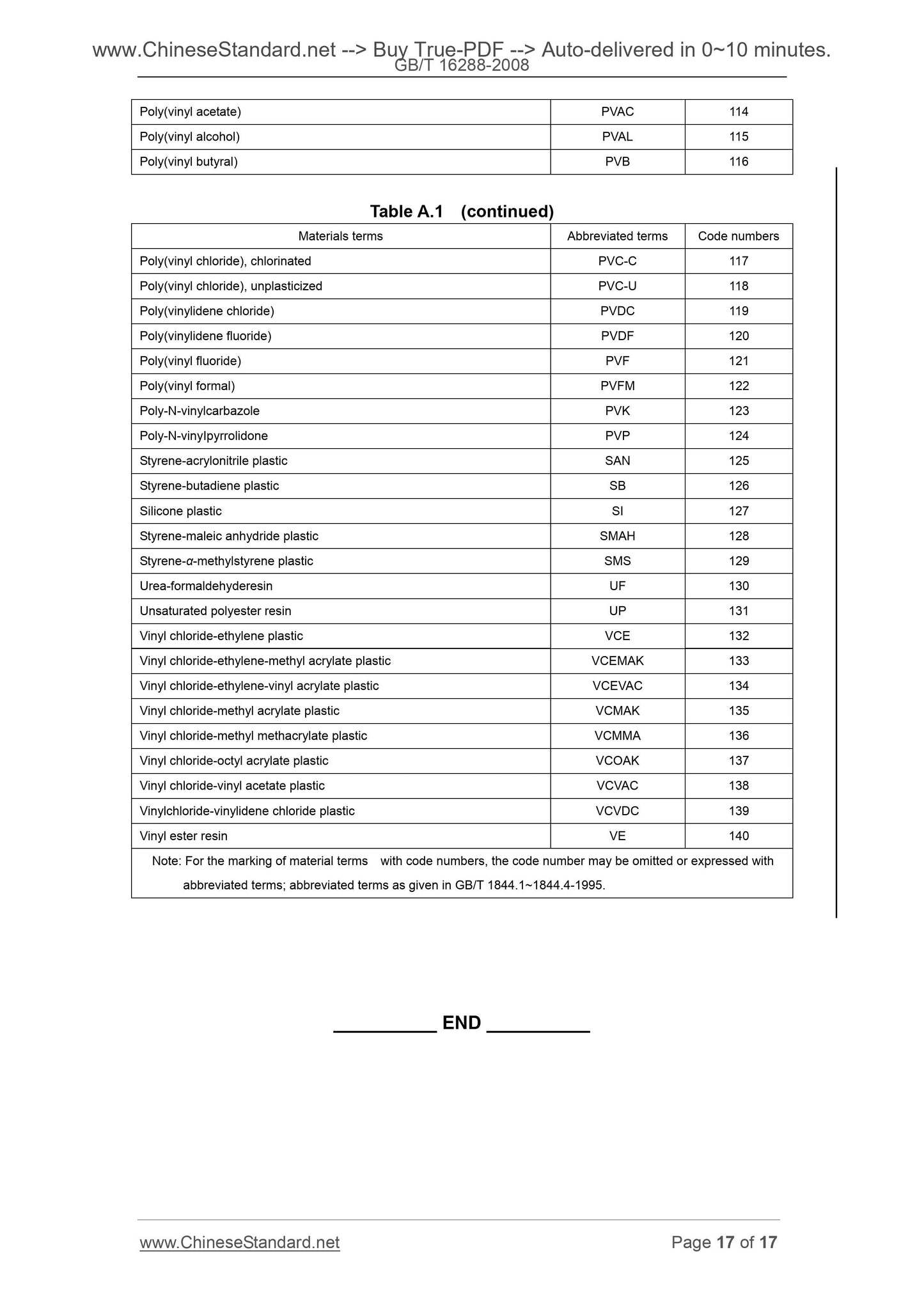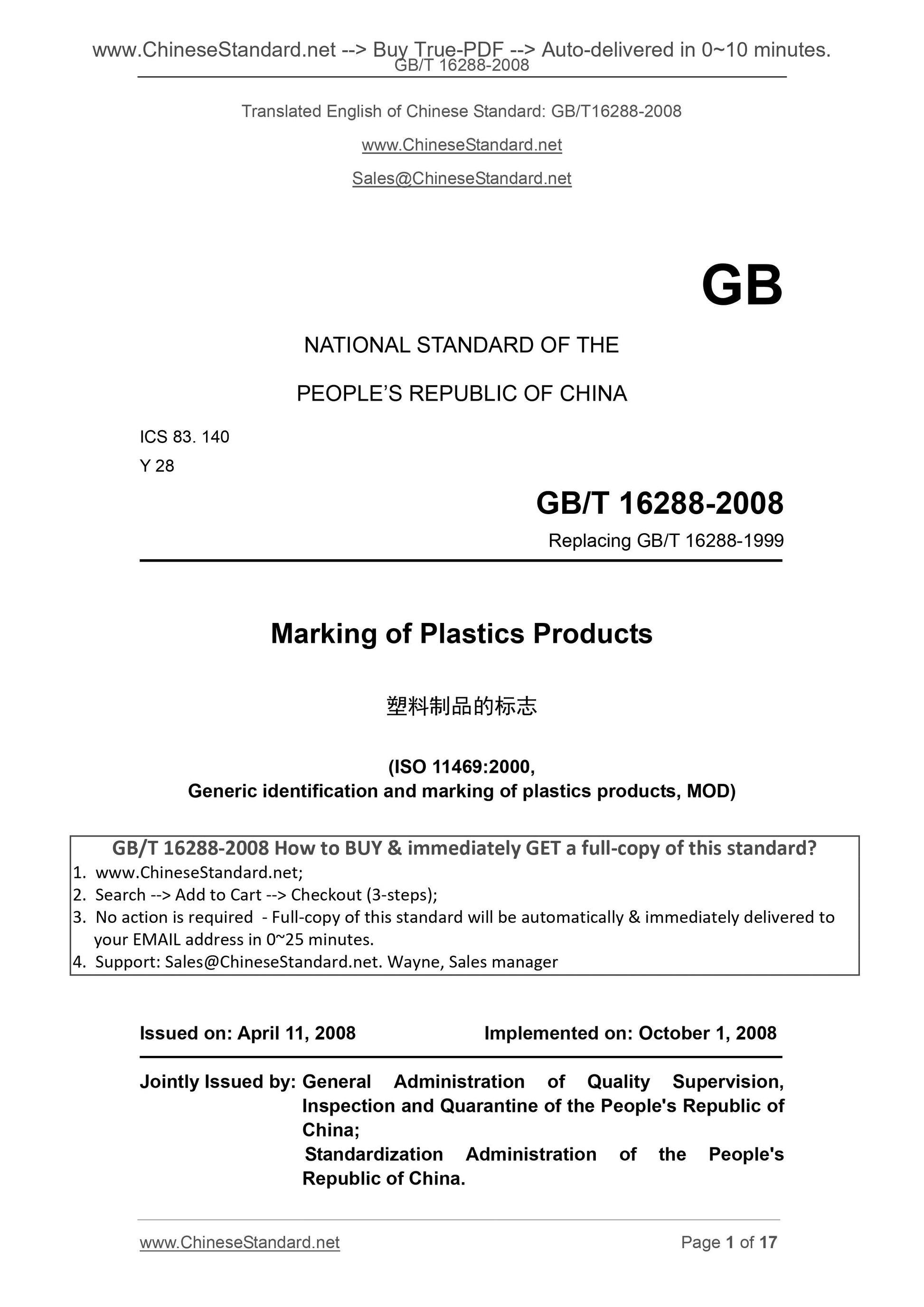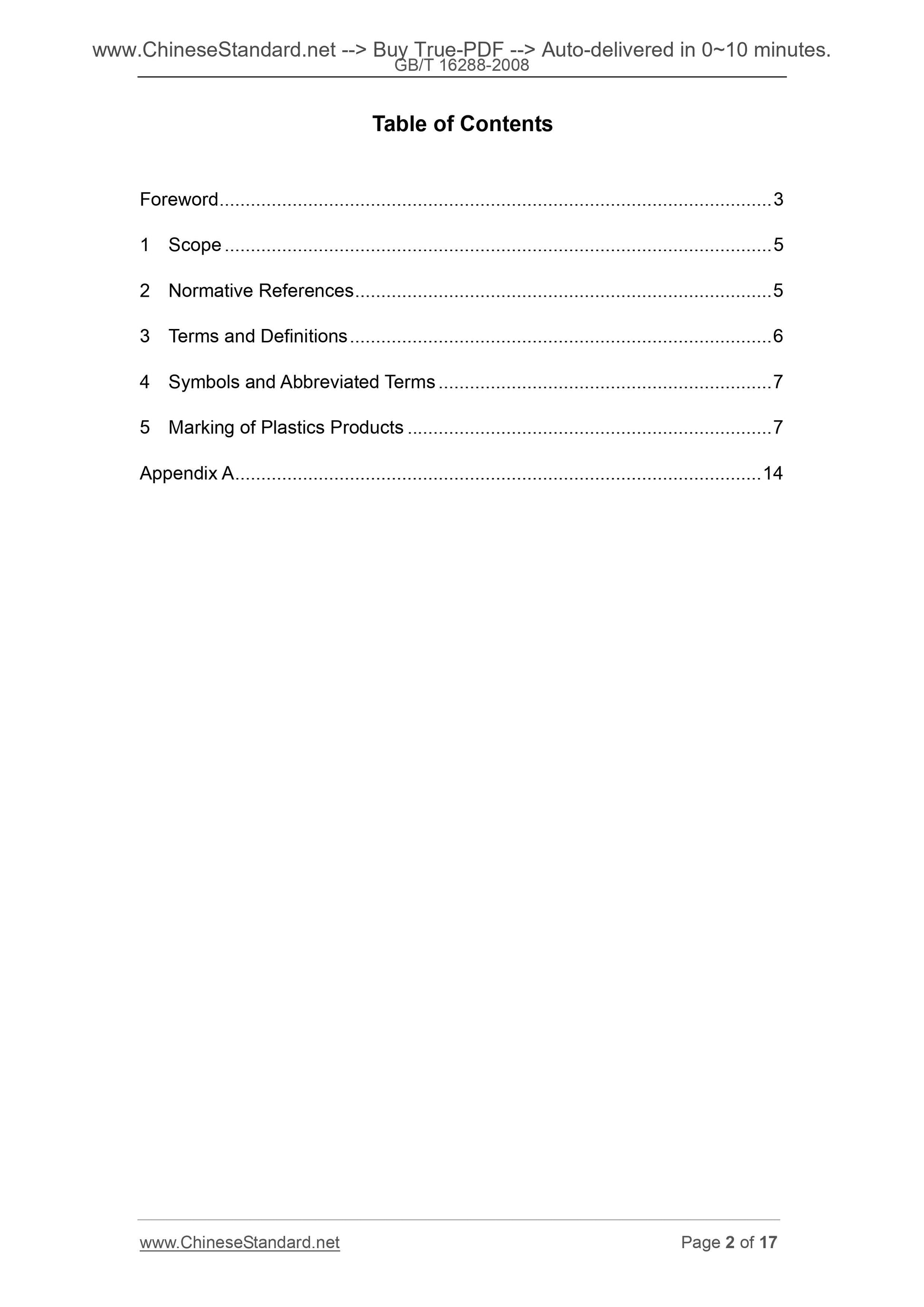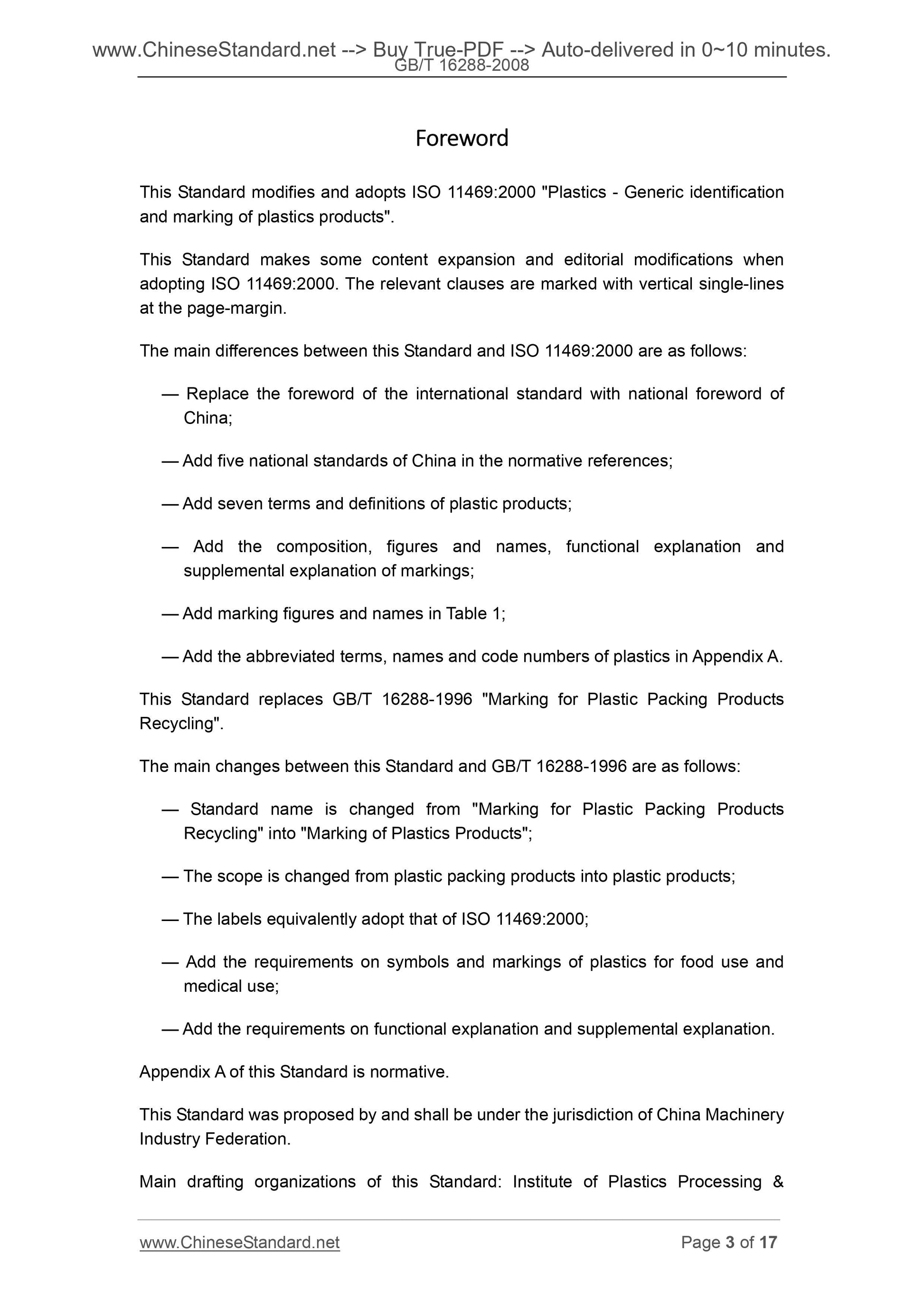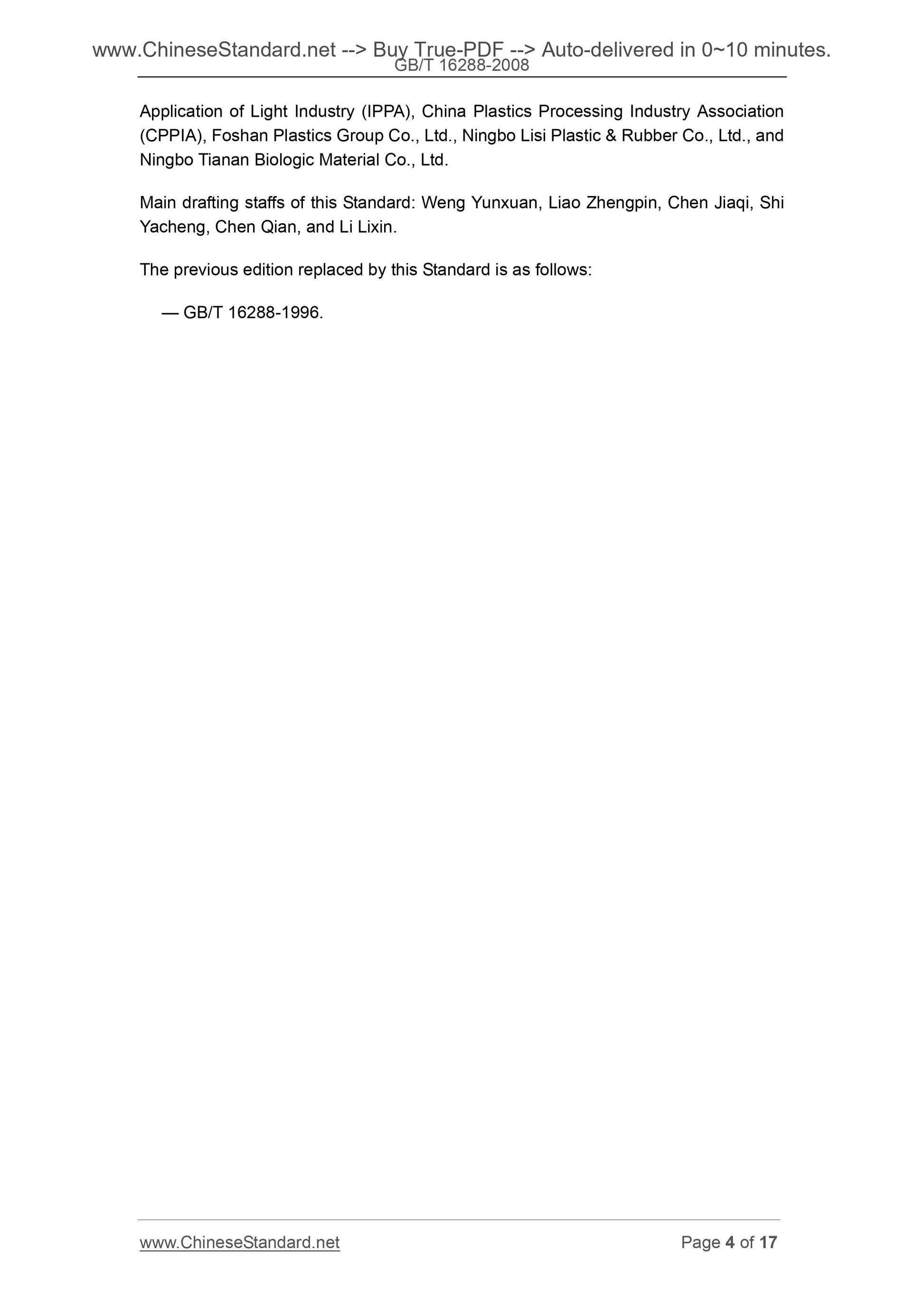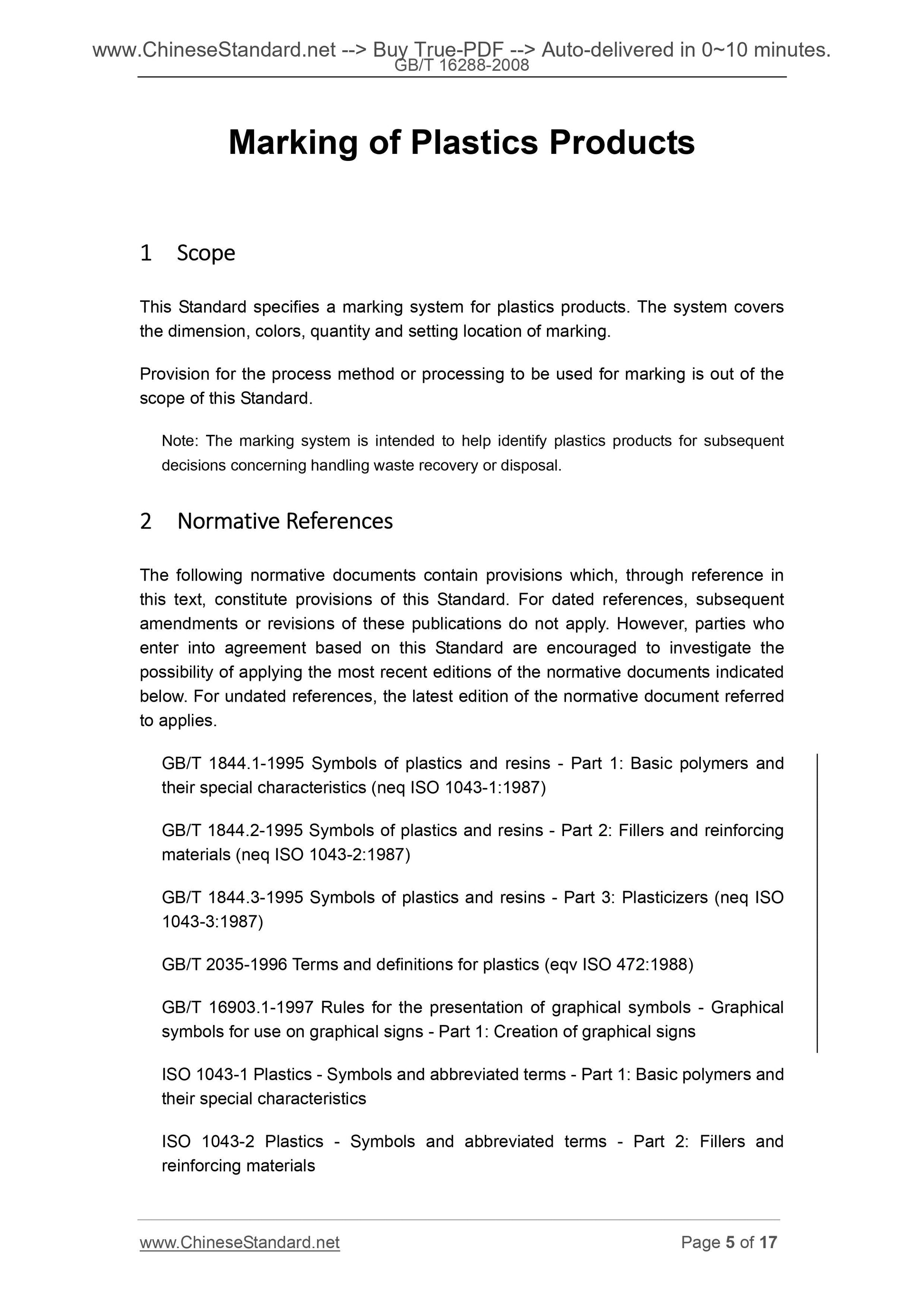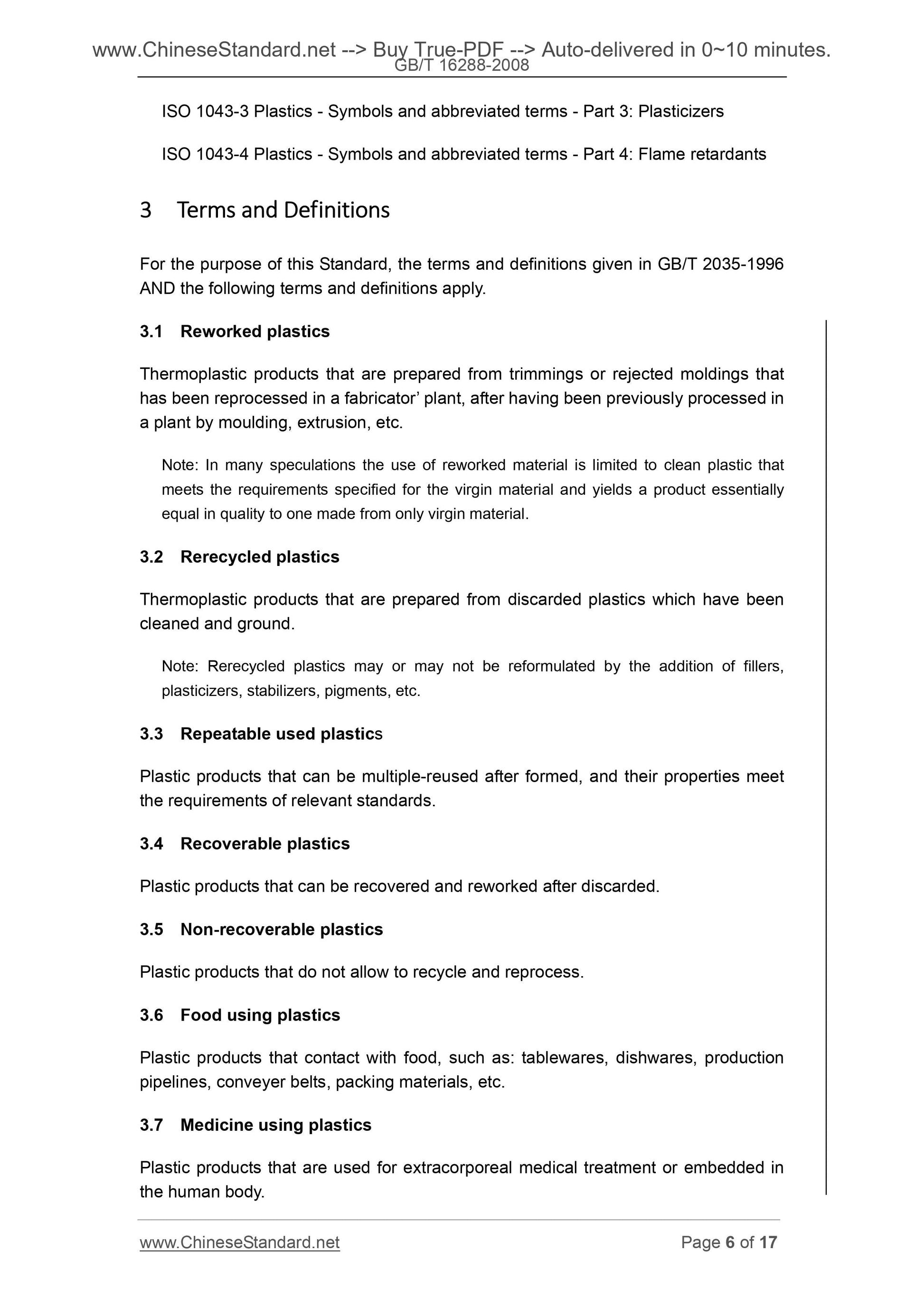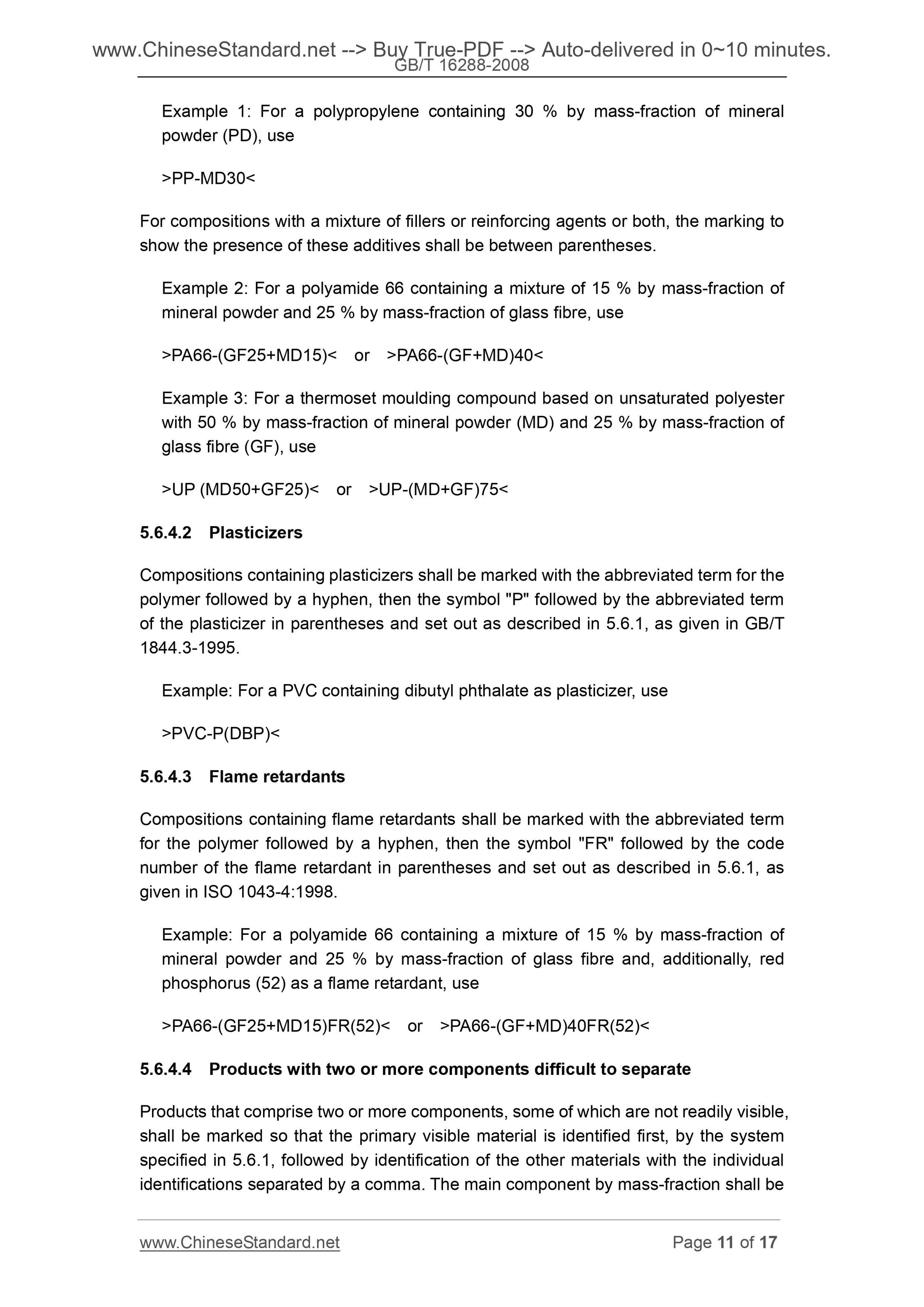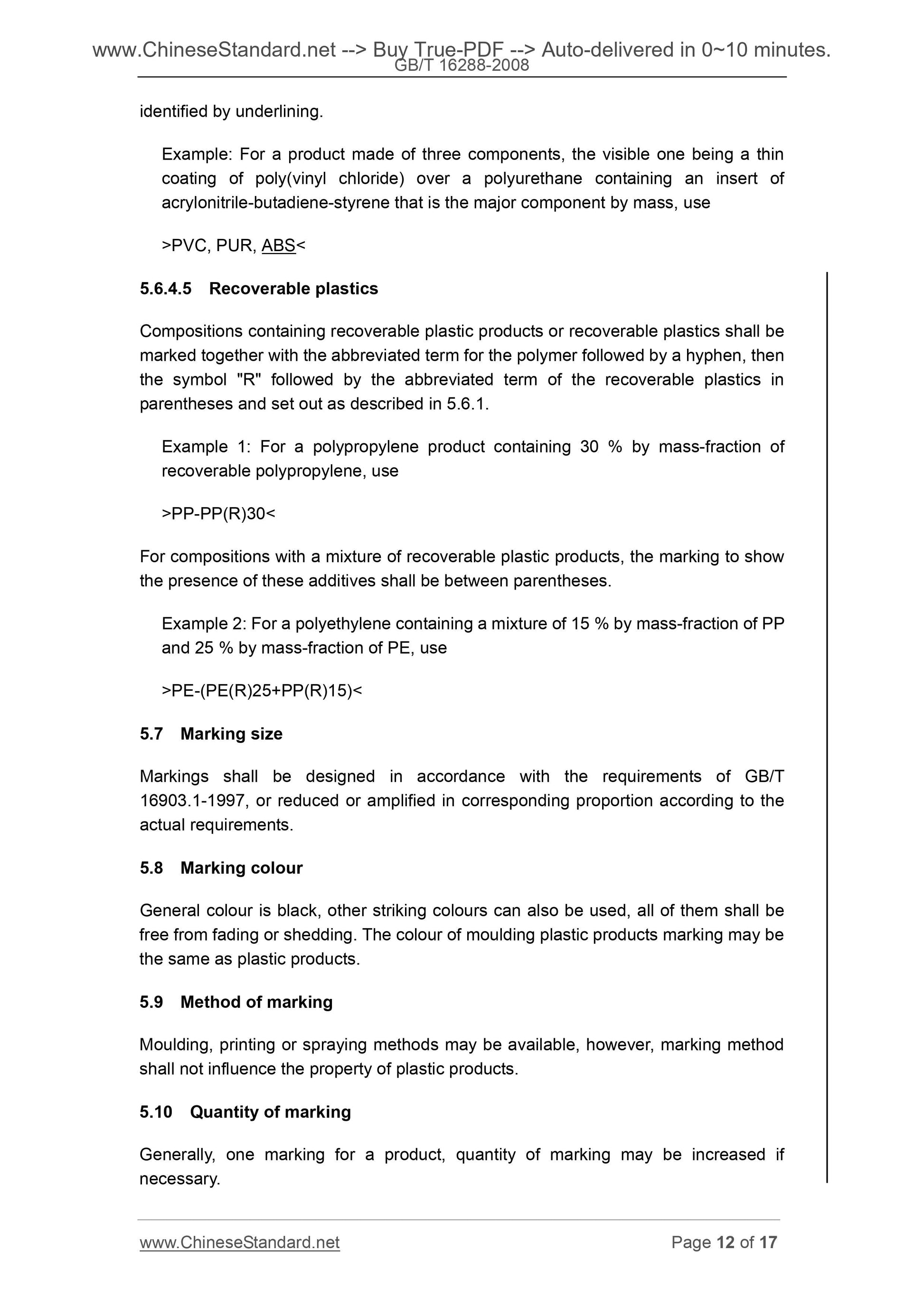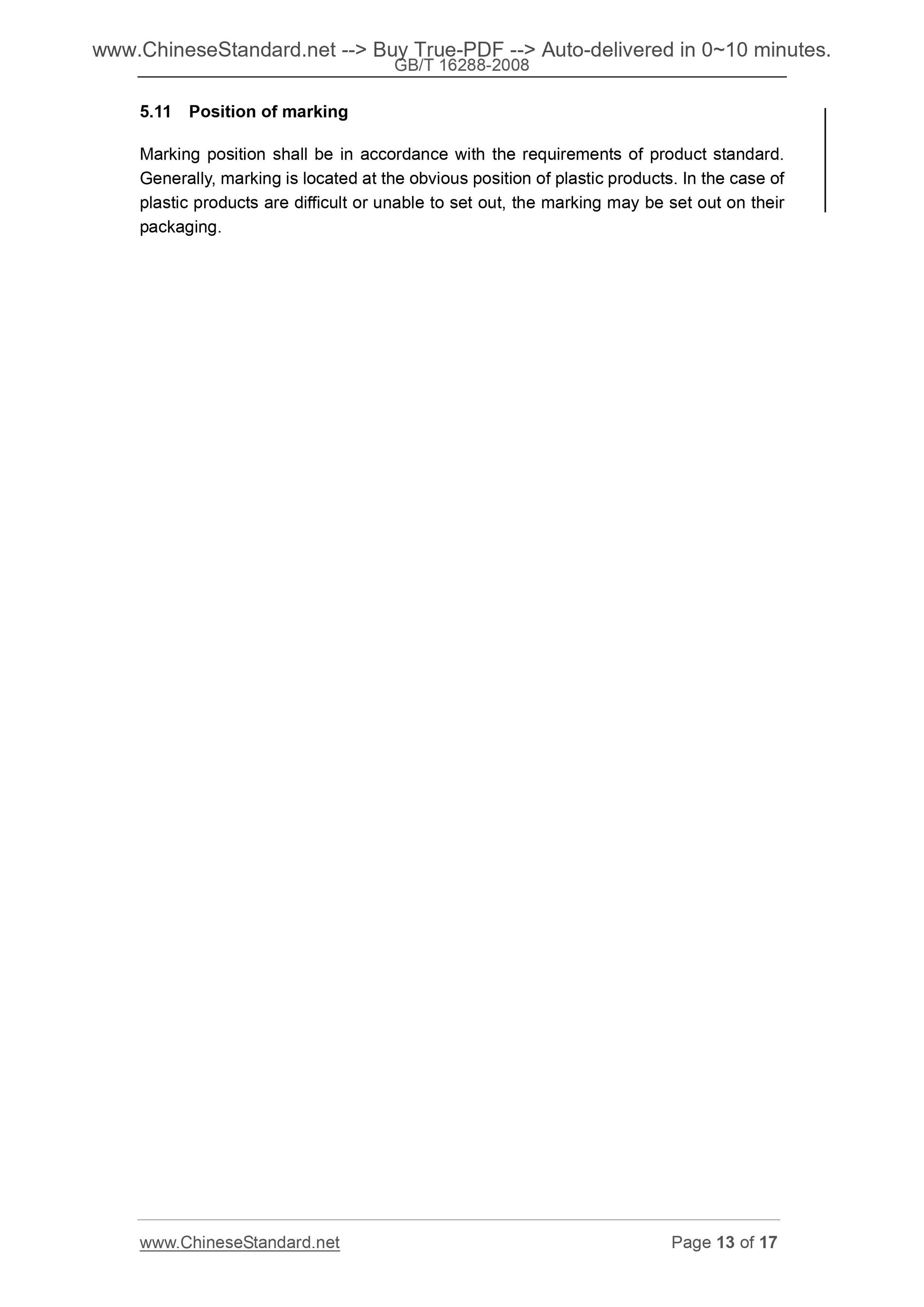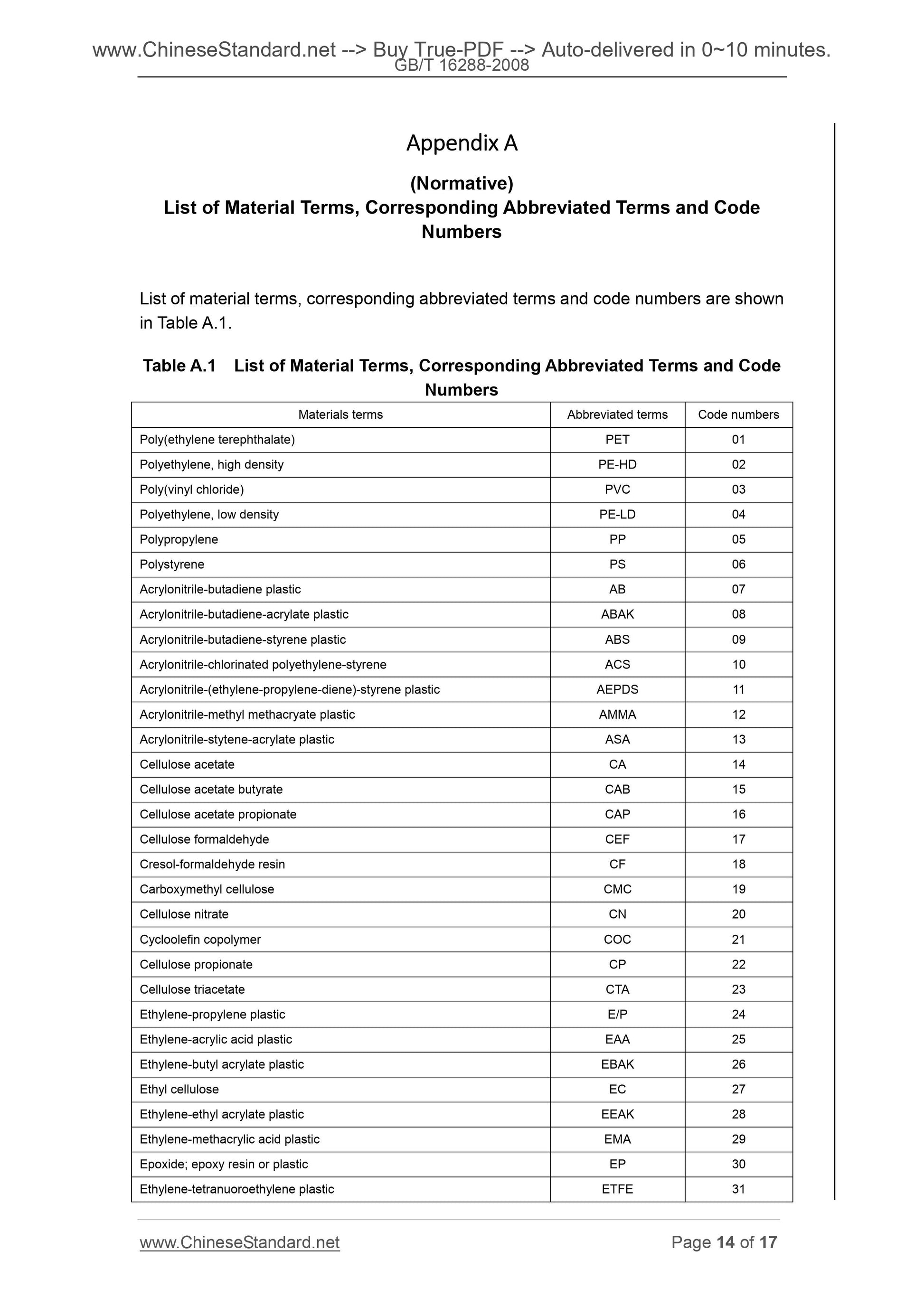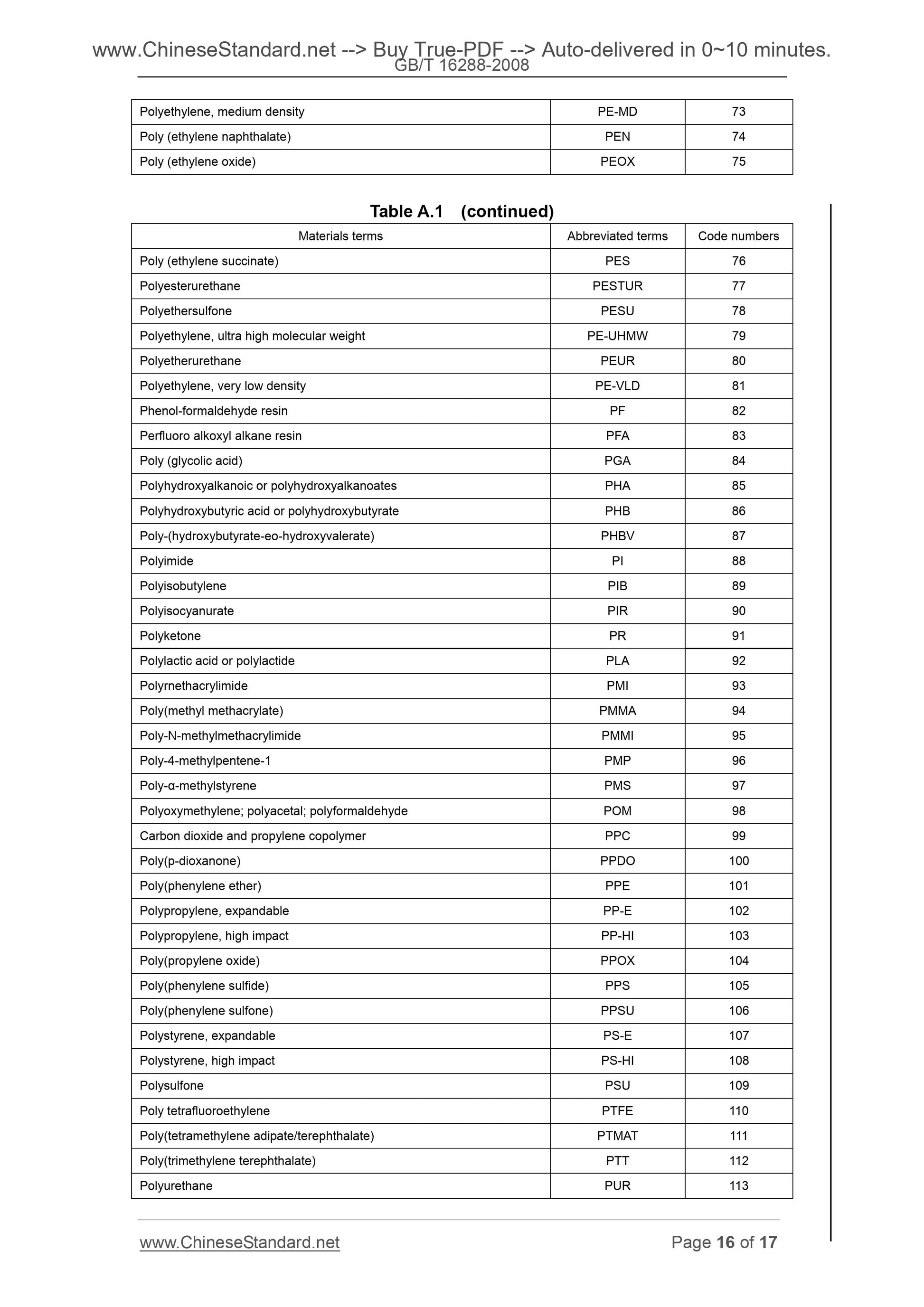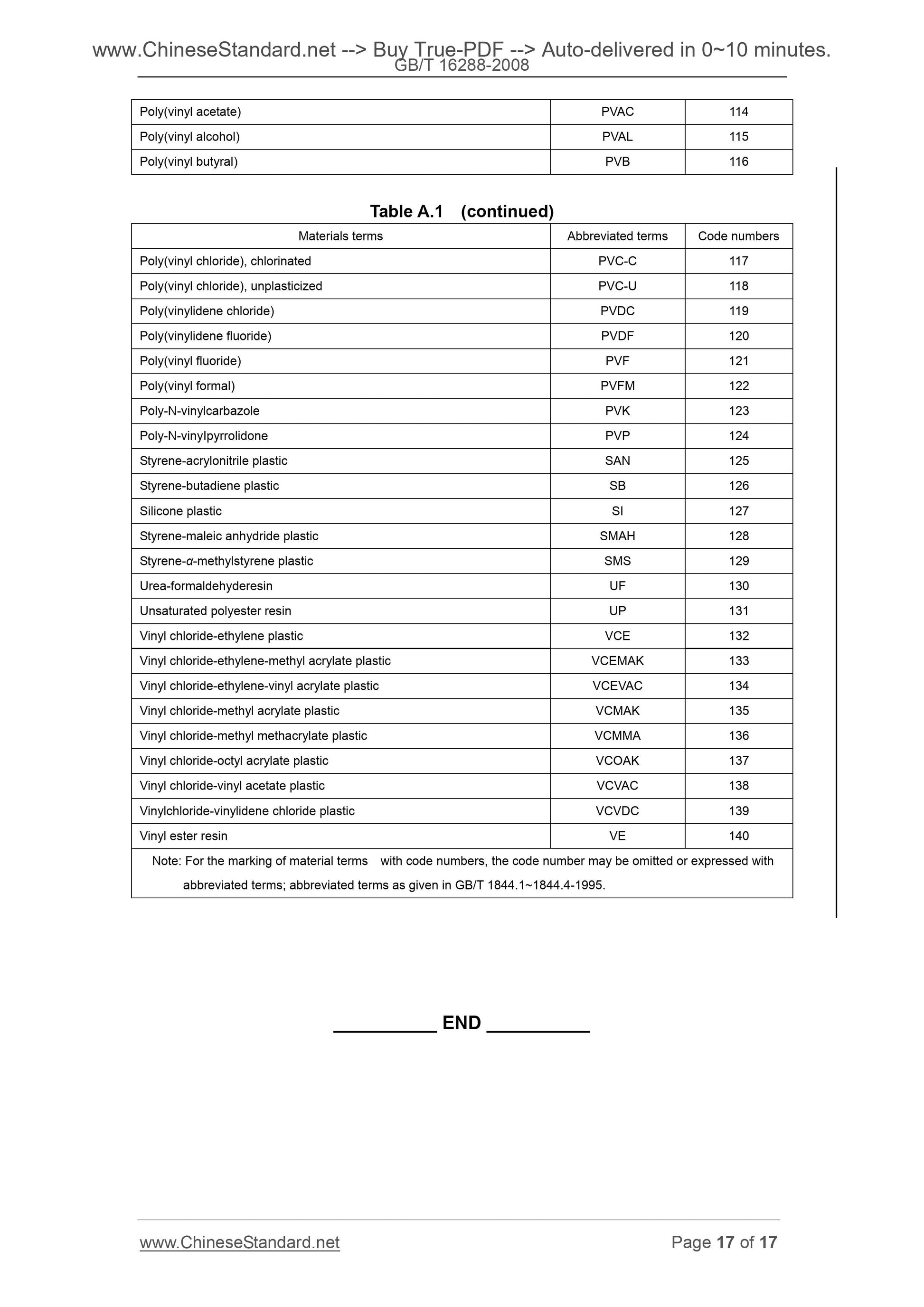1
/
of
12
PayPal, credit cards. Download editable-PDF and invoice in 1 second!
GB/T 16288-2008 English PDF (GBT16288-2008)
GB/T 16288-2008 English PDF (GBT16288-2008)
Regular price
$70.00 USD
Regular price
Sale price
$70.00 USD
Unit price
/
per
Shipping calculated at checkout.
Couldn't load pickup availability
Delivery: 3 seconds. Download true-PDF + Invoice.Newer version: (Replacing this standard) GB/T 16288-2024
Get QUOTATION in 1-minute: Click GB/T 16288-2008
Historical versions: GB/T 16288-2008
Preview True-PDF (Reload/Scroll if blank)
GB/T 16288-2008: Marking of plastics products
GB/T 16288-2008
GB
NATIONAL STANDARD OF THE
PEOPLE’S REPUBLIC OF CHINA
ICS 83. 140
Y 28
Replacing GB/T 16288-1999
Marking of Plastics Products
(ISO 11469.2000,
Generic identification and marking of plastics products, MOD)
ISSUED ON. APRIL 11, 2008
IMPLEMENTED ON. OCTOBER 1, 2008
Jointly Issued by. General Administration of Quality Supervision,
Inspection and Quarantine of the People's Republic of
China;
Standardization Administration of the People's
Republic of China.
Table of Contents
Foreword ... 3
1 Scope ... 5
2 Normative References ... 5
3 Terms and Definitions ... 6
4 Symbols and Abbreviated Terms ... 7
5 Marking of Plastics Products ... 7
Appendix A ... 14
Foreword
This Standard modifies and adopts ISO 11469.2000 "Plastics - Generic identification
and marking of plastics products".
This Standard makes some content expansion and editorial modifications when
adopting ISO 11469.2000. The relevant clauses are marked with vertical single-lines
at the page-margin.
The main differences between this Standard and ISO 11469.2000 are as follows.
— Replace the foreword of the international standard with national foreword of
China;
— Add five national standards of China in the normative references;
— Add seven terms and definitions of plastic products;
— Add the composition, figures and names, functional explanation and
supplemental explanation of markings;
— Add marking figures and names in Table 1;
— Add the abbreviated terms, names and code numbers of plastics in Appendix A.
This Standard replaces GB/T 16288-1996 "Marking for Plastic Packing Products
Recycling".
The main changes between this Standard and GB/T 16288-1996 are as follows.
— Standard name is changed from "Marking for Plastic Packing Products
Recycling" into "Marking of Plastics Products";
— The scope is changed from plastic packing products into plastic products;
— The labels equivalently adopt that of ISO 11469.2000;
— Add the requirements on symbols and markings of plastics for food use and
medical use;
— Add the requirements on functional explanation and supplemental explanation.
Appendix A of this Standard is normative.
This Standard was proposed by and shall be under the jurisdiction of China Machinery
Industry Federation.
Main drafting organizations of this Standard. Institute of Plastics Processing and
Application of Light Industry (IPPA), China Plastics Processing Industry Association
(CPPIA), Foshan Plastics Group Co., Ltd., Ningbo Lisi Plastic and Rubber Co., Ltd., and
Ningbo Tianan Biologic Material Co., Ltd.
Main drafting staffs of this Standard. Weng Yunxuan, Liao Zhengpin, Chen Jiaqi, Shi
Yacheng, Chen Qian, and Li Lixin.
The previous edition replaced by this Standard is as follows.
— GB/T 16288-1996.
Marking of Plastics Products
1 Scope
This Standard specifies a marking system for plastics products. The system covers
the dimension, colors, quantity and setting location of marking.
Provision for the process method or processing to be used for marking is out of the
scope of this Standard.
Note. The marking system is intended to help identify plastics products for subsequent
decisions concerning handling waste recovery or disposal.
2 Normative References
The following normative documents contain provisions which, through reference in
this text, constitute provisions of this Standard. For dated references, subsequent
amendments or revisions of these publications do not apply. However, parties who
enter into agreement based on this Standard are encouraged to investigate the
possibility of applying the most recent editions of the normative documents indicated
below. For undated references, the latest edition of the normative document referred
to applies.
GB/T 1844.1-1995 Symbols of plastics and resins - Part 1. Basic polymers and
their special characteristics (neq ISO 1043-1.1987)
GB/T 1844.2-1995 Symbols of plastics and resins - Part 2. Fillers and reinforcing
materials (neq ISO 1043-2.1987)
GB/T 1844.3-1995 Symbols of plastics and resins - Part 3. Plasticizers (neq ISO
1043-3.1987)
GB/T 2035-1996 Terms and definitions for plastics (eqv ISO 472.1988)
GB/T 16903.1-1997 Rules for the presentation of graphical symbols - Graphical
symbols for use on graphical signs - Part 1. Creation of graphical signs
ISO 1043-1 Plastics - Symbols and abbreviated terms - Part 1. Basic polymers and
their special characteristics
ISO 1043-2 Plastics - Symbols and abbreviated terms - Part 2. Fillers and
reinforcing materials
ISO 1043-3 Plastics - Symbols and abbreviated terms - Part 3. Plasticizers
ISO 1043-4 Plastics - Symbols and abbreviated terms - Part 4. Flame retardants
3 Terms and Definitions
For the purpose of this Standard, the terms and definitions given in GB/T 2035-1996
AND the following terms and definitions apply.
3.1 Reworked plastics
Thermoplastic products that are prepared from trimmings or rejected moldings that
has been reprocessed in a fabricator’ plant, after having been previously processed in
a plant by moulding, extrusion, etc.
Note. In many speculations the use of reworked material is limited to clean plastic that
meets the requirements specified for the virgin material and yields a product essentially
equal in quality to one made from only virgin material.
3.2 Rerecycled plastics
Thermoplastic products that are prepared from discarded plastics which have been
cleaned and ground.
Note. Rerecycled plastics may or may not be reformulated by the addition of fillers,
plasticizers, stabilizers, pigments, etc.
3.3 Repeatable used plastics
Plastic products that can be multiple-reused after formed, and their properties meet
the requirements of relevant standards.
3.4 Recoverable plastics
Plastic products that can be recovered and reworked after discarded.
3.5 Non-recoverable plastics
Plastic products that do not allow to recycle and reprocess.
3.6 Food using plastics
Plastic products that contact with food, such as. tablewares, dishwares, production
pipelines, conveyer belts, packing materials, etc.
3.7 Medicine using plastics
Plastic products that are used for extracorporeal medical treatment or embedded in
the human body.
Example 1. For a polypropylene containing 30 % by mass-fraction of mineral
powder (PD), use
>PP-MD30<
For compositions with a mixture of fillers or reinforcing agents or both, the marking to
show the presence of these additives shall be between parentheses.
Example 2. For a polyamide 66 containing a mixture of 15 % by mass-fraction of
mineral powder and 25 % by mass-fraction of glass fibre, use
>PA66-(GF25+MD15)< or >PA66-(GF+MD)40<
Example 3. For a thermoset moulding compound based on unsaturated polyester
with 50 % by mass-fraction of mineral powder (MD) and 25 % by mass-fraction of
glass fibre (GF), use
>UP (MD50+GF25)< or >UP-(MD+GF)75<
5.6.4.2 Plasticizers
Compositions containing plasticizers shall be marked with the abbreviated term for the
polymer followed by a hyphen, then the symbol "P" followed by the abbreviated term
of the plasticizer in parentheses and set out as described in 5.6.1, as given in GB/T
1844.3-1995.
Example. For a PVC containing dibutyl phthalate as plasticizer, use
>PVC-P(DBP)<
5.6.4.3 Flame retardants
Compositions containing flame retardants shall be marked with the abbreviated term
for the polymer followed by a hyphen, then th...
Get QUOTATION in 1-minute: Click GB/T 16288-2008
Historical versions: GB/T 16288-2008
Preview True-PDF (Reload/Scroll if blank)
GB/T 16288-2008: Marking of plastics products
GB/T 16288-2008
GB
NATIONAL STANDARD OF THE
PEOPLE’S REPUBLIC OF CHINA
ICS 83. 140
Y 28
Replacing GB/T 16288-1999
Marking of Plastics Products
(ISO 11469.2000,
Generic identification and marking of plastics products, MOD)
ISSUED ON. APRIL 11, 2008
IMPLEMENTED ON. OCTOBER 1, 2008
Jointly Issued by. General Administration of Quality Supervision,
Inspection and Quarantine of the People's Republic of
China;
Standardization Administration of the People's
Republic of China.
Table of Contents
Foreword ... 3
1 Scope ... 5
2 Normative References ... 5
3 Terms and Definitions ... 6
4 Symbols and Abbreviated Terms ... 7
5 Marking of Plastics Products ... 7
Appendix A ... 14
Foreword
This Standard modifies and adopts ISO 11469.2000 "Plastics - Generic identification
and marking of plastics products".
This Standard makes some content expansion and editorial modifications when
adopting ISO 11469.2000. The relevant clauses are marked with vertical single-lines
at the page-margin.
The main differences between this Standard and ISO 11469.2000 are as follows.
— Replace the foreword of the international standard with national foreword of
China;
— Add five national standards of China in the normative references;
— Add seven terms and definitions of plastic products;
— Add the composition, figures and names, functional explanation and
supplemental explanation of markings;
— Add marking figures and names in Table 1;
— Add the abbreviated terms, names and code numbers of plastics in Appendix A.
This Standard replaces GB/T 16288-1996 "Marking for Plastic Packing Products
Recycling".
The main changes between this Standard and GB/T 16288-1996 are as follows.
— Standard name is changed from "Marking for Plastic Packing Products
Recycling" into "Marking of Plastics Products";
— The scope is changed from plastic packing products into plastic products;
— The labels equivalently adopt that of ISO 11469.2000;
— Add the requirements on symbols and markings of plastics for food use and
medical use;
— Add the requirements on functional explanation and supplemental explanation.
Appendix A of this Standard is normative.
This Standard was proposed by and shall be under the jurisdiction of China Machinery
Industry Federation.
Main drafting organizations of this Standard. Institute of Plastics Processing and
Application of Light Industry (IPPA), China Plastics Processing Industry Association
(CPPIA), Foshan Plastics Group Co., Ltd., Ningbo Lisi Plastic and Rubber Co., Ltd., and
Ningbo Tianan Biologic Material Co., Ltd.
Main drafting staffs of this Standard. Weng Yunxuan, Liao Zhengpin, Chen Jiaqi, Shi
Yacheng, Chen Qian, and Li Lixin.
The previous edition replaced by this Standard is as follows.
— GB/T 16288-1996.
Marking of Plastics Products
1 Scope
This Standard specifies a marking system for plastics products. The system covers
the dimension, colors, quantity and setting location of marking.
Provision for the process method or processing to be used for marking is out of the
scope of this Standard.
Note. The marking system is intended to help identify plastics products for subsequent
decisions concerning handling waste recovery or disposal.
2 Normative References
The following normative documents contain provisions which, through reference in
this text, constitute provisions of this Standard. For dated references, subsequent
amendments or revisions of these publications do not apply. However, parties who
enter into agreement based on this Standard are encouraged to investigate the
possibility of applying the most recent editions of the normative documents indicated
below. For undated references, the latest edition of the normative document referred
to applies.
GB/T 1844.1-1995 Symbols of plastics and resins - Part 1. Basic polymers and
their special characteristics (neq ISO 1043-1.1987)
GB/T 1844.2-1995 Symbols of plastics and resins - Part 2. Fillers and reinforcing
materials (neq ISO 1043-2.1987)
GB/T 1844.3-1995 Symbols of plastics and resins - Part 3. Plasticizers (neq ISO
1043-3.1987)
GB/T 2035-1996 Terms and definitions for plastics (eqv ISO 472.1988)
GB/T 16903.1-1997 Rules for the presentation of graphical symbols - Graphical
symbols for use on graphical signs - Part 1. Creation of graphical signs
ISO 1043-1 Plastics - Symbols and abbreviated terms - Part 1. Basic polymers and
their special characteristics
ISO 1043-2 Plastics - Symbols and abbreviated terms - Part 2. Fillers and
reinforcing materials
ISO 1043-3 Plastics - Symbols and abbreviated terms - Part 3. Plasticizers
ISO 1043-4 Plastics - Symbols and abbreviated terms - Part 4. Flame retardants
3 Terms and Definitions
For the purpose of this Standard, the terms and definitions given in GB/T 2035-1996
AND the following terms and definitions apply.
3.1 Reworked plastics
Thermoplastic products that are prepared from trimmings or rejected moldings that
has been reprocessed in a fabricator’ plant, after having been previously processed in
a plant by moulding, extrusion, etc.
Note. In many speculations the use of reworked material is limited to clean plastic that
meets the requirements specified for the virgin material and yields a product essentially
equal in quality to one made from only virgin material.
3.2 Rerecycled plastics
Thermoplastic products that are prepared from discarded plastics which have been
cleaned and ground.
Note. Rerecycled plastics may or may not be reformulated by the addition of fillers,
plasticizers, stabilizers, pigments, etc.
3.3 Repeatable used plastics
Plastic products that can be multiple-reused after formed, and their properties meet
the requirements of relevant standards.
3.4 Recoverable plastics
Plastic products that can be recovered and reworked after discarded.
3.5 Non-recoverable plastics
Plastic products that do not allow to recycle and reprocess.
3.6 Food using plastics
Plastic products that contact with food, such as. tablewares, dishwares, production
pipelines, conveyer belts, packing materials, etc.
3.7 Medicine using plastics
Plastic products that are used for extracorporeal medical treatment or embedded in
the human body.
Example 1. For a polypropylene containing 30 % by mass-fraction of mineral
powder (PD), use
>PP-MD30<
For compositions with a mixture of fillers or reinforcing agents or both, the marking to
show the presence of these additives shall be between parentheses.
Example 2. For a polyamide 66 containing a mixture of 15 % by mass-fraction of
mineral powder and 25 % by mass-fraction of glass fibre, use
>PA66-(GF25+MD15)< or >PA66-(GF+MD)40<
Example 3. For a thermoset moulding compound based on unsaturated polyester
with 50 % by mass-fraction of mineral powder (MD) and 25 % by mass-fraction of
glass fibre (GF), use
>UP (MD50+GF25)< or >UP-(MD+GF)75<
5.6.4.2 Plasticizers
Compositions containing plasticizers shall be marked with the abbreviated term for the
polymer followed by a hyphen, then the symbol "P" followed by the abbreviated term
of the plasticizer in parentheses and set out as described in 5.6.1, as given in GB/T
1844.3-1995.
Example. For a PVC containing dibutyl phthalate as plasticizer, use
>PVC-P(DBP)<
5.6.4.3 Flame retardants
Compositions containing flame retardants shall be marked with the abbreviated term
for the polymer followed by a hyphen, then th...
Share
